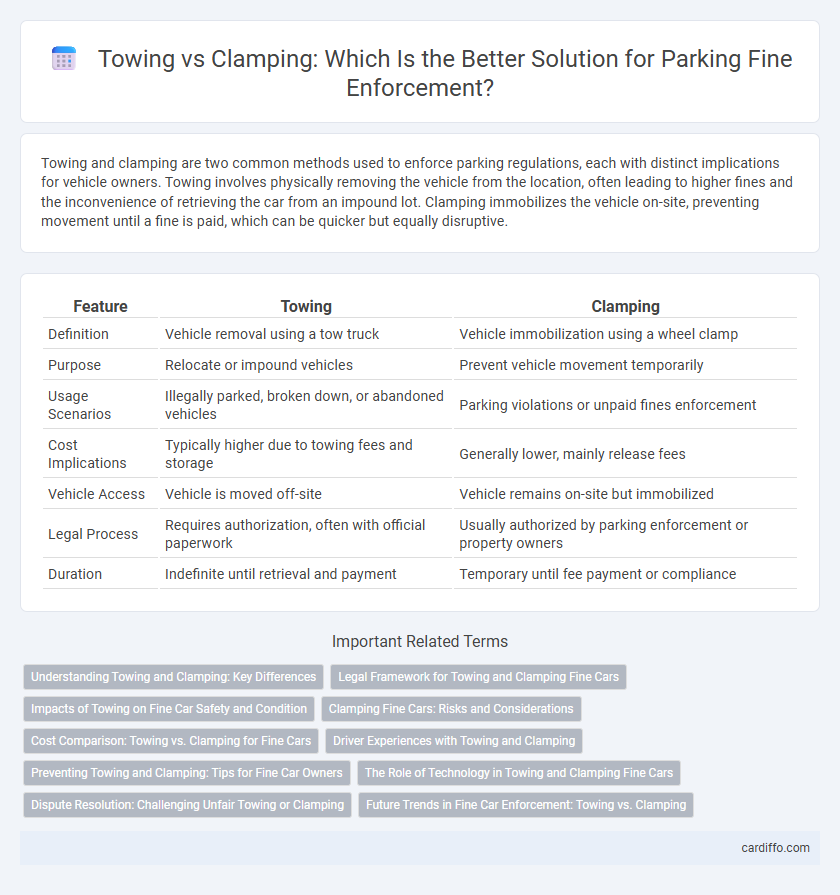Towing and clamping are two common methods used to enforce parking regulations, each with distinct implications for vehicle owners. Towing involves physically removing the vehicle from the location, often leading to higher fines and the inconvenience of retrieving the car from an impound lot. Clamping immobilizes the vehicle on-site, preventing movement until a fine is paid, which can be quicker but equally disruptive.
Table of Comparison
| Feature | Towing | Clamping |
|---|---|---|
| Definition | Vehicle removal using a tow truck | Vehicle immobilization using a wheel clamp |
| Purpose | Relocate or impound vehicles | Prevent vehicle movement temporarily |
| Usage Scenarios | Illegally parked, broken down, or abandoned vehicles | Parking violations or unpaid fines enforcement |
| Cost Implications | Typically higher due to towing fees and storage | Generally lower, mainly release fees |
| Vehicle Access | Vehicle is moved off-site | Vehicle remains on-site but immobilized |
| Legal Process | Requires authorization, often with official paperwork | Usually authorized by parking enforcement or property owners |
| Duration | Indefinite until retrieval and payment | Temporary until fee payment or compliance |
Understanding Towing and Clamping: Key Differences
Towing involves physically transporting a vehicle using a tow truck, typically for violation of parking rules, breakdowns, or accidents, while clamping immobilizes the vehicle by attaching a wheel clamp to prevent movement. Clamping is often used as a temporary enforcement method to ensure compliance or payment of fines, whereas towing removes the vehicle from the location entirely. Understanding these key differences helps vehicle owners respond appropriately to each situation and avoid potential fees or legal issues.
Legal Framework for Towing and Clamping Fine Cars
The legal framework governing towing and clamping fine cars varies significantly by jurisdiction, with specific regulations detailing permissible actions, required signage, and notification procedures to protect vehicle owners' rights. Towing typically involves strict protocols including documented authorizations, prompt owner notification, and clear grounds for removal, while clamping laws often mandate visible warnings and impose limits on release fees and durations. Understanding these legal distinctions helps ensure compliance and safeguards against potential liability or unlawful seizure in urban and private property settings.
Impacts of Towing on Fine Car Safety and Condition
Towing can cause significant damage to a fine car's suspension, tires, and undercarriage due to improper lifting or dragging techniques. The risk of paint scratches, alignment issues, and hidden mechanical problems increases when a delicate vehicle is towed without specialized equipment. Ensuring the use of flatbed tow trucks or professional services minimizes these adverse impacts on a high-value automobile's safety and condition.
Clamping Fine Cars: Risks and Considerations
Clamping fine cars poses significant risks such as potential paint damage and expensive repairs, as the clamping device can scratch or dent the vehicle's delicate surfaces. Insurance may not cover damages caused by improper clamping, increasing financial liability for owners of luxury vehicles. Experts recommend professional towing services with specialized equipment designed for high-end cars to avoid costly damages and ensure safe vehicle handling.
Cost Comparison: Towing vs. Clamping for Fine Cars
Towing fine cars typically incurs higher costs due to specialized equipment and careful handling requirements, often ranging from $100 to $300 per tow depending on distance and vehicle type. Clamping tends to be less expensive, usually costing between $50 and $150, but it may cause minor cosmetic damage or inconvenience to luxury vehicles. Considering the high value of fine cars, towing offers safer transportation despite the higher initial expense, making it a preferred choice for preserving vehicle integrity.
Driver Experiences with Towing and Clamping
Drivers facing towing often experience higher stress due to immediate vehicle removal and higher retrieval fees, creating significant inconvenience. Clamping typically results in a less disruptive experience, as drivers can often pay fines on-site to avoid vehicle removal, reducing downtime. Both methods cause frustration, but towing frequently leads to longer delays and increased financial burden for drivers.
Preventing Towing and Clamping: Tips for Fine Car Owners
Car owners can prevent towing and clamping by parking in designated areas with clear signage to avoid violations. Using apps or local authority websites to check parking regulations and restrictions in real-time helps ensure compliance. Keeping payment receipts for parking fees and promptly addressing any parking tickets reduces the risk of fines or vehicle immobilization.
The Role of Technology in Towing and Clamping Fine Cars
Advanced GPS tracking and immobilizer systems have revolutionized the towing and clamping of fine cars by enabling precise vehicle location and secure handling, minimizing damage risks. High-tech wheel clamps with sensors monitor unauthorized movements, while tow trucks equipped with hydraulic lifts and computerized controls ensure safe, damage-free towing. Integration of IoT and real-time monitoring platforms enhances operational efficiency and vehicle security throughout the towing and clamping process.
Dispute Resolution: Challenging Unfair Towing or Clamping
Challenging unfair towing or clamping requires understanding local laws and gathering evidence such as photos, receipts, and witness statements to support your claim. Dispute resolution often involves contacting the towing or clamping company, filing complaints with consumer protection agencies, or pursuing legal action in small claims court. Prompt response and thorough documentation increase the chances of a favorable outcome in recovering fees or securing compensation.
Future Trends in Fine Car Enforcement: Towing vs. Clamping
Emerging technologies like IoT sensors and AI-driven enforcement systems are transforming fine car enforcement by enabling real-time monitoring to optimize towing and clamping decisions. Automated systems reduce operational costs and enhance compliance rates, shifting preference towards clamping for low-risk infractions and towing for serious violations. Data analytics will further refine enforcement strategies, ensuring a balanced approach that maximizes efficiency and minimizes community disruption.
Towing vs Clamping Infographic

 cardiffo.com
cardiffo.com